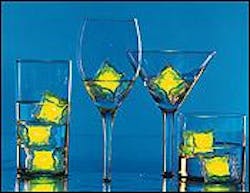There's nothing like a cold drink in hand to take one's mind off weighty subjects like optoelectronics. Watching the sunset from the back porch with a tumblerful of refreshment can calm even the most harried researcher—but that feeling of escape might just disappear as twilight fades, thanks to an invention by Carl VanderSchuit, founder of Litecubes (San Diego, CA). His glow-in-the-dark "ice cubes," which light with a tap, each contain a light-emitting diode (LED)—some using the latest gallium nitride technology.
A professional photographer, VanderSchuit often worked with the transparent acrylic ice cubes used to beautify photographs of cola, whiskey, and other beverages. One Halloween, while making holiday decorations, he imagined light emanating from inside a glass. Thus was born the glowing ice cube, although it took 15 months to come up with the right way to turn it on and off, according to David Warren, chief of research and development for Litecubes. The sealed device, which runs for 12 hours of continuous use on a lithium battery, at first seemed to require a complicated switch, but the final design works simply by jostling the battery against or away from an electrical contact. The cube contains a nontoxic gel that freezes to cool a drink like the real thing.
Augmenting the lineup of yellow, orange, green (shown here), and red are the new blue- and white-emitting cubes. But one oft-requested color is missing, says VanderSchuit, and that is purple. Because the hue is a combination of colors from each end of the visible spectrum—blue and red—no single-color LED produces purple. VanderSchuit is undeterred, however, seeking perhaps a blue LED in combination with a red phosphor—a task that should be of no concern to anyone holding a purple drink, even an optoelectronics researcher.

